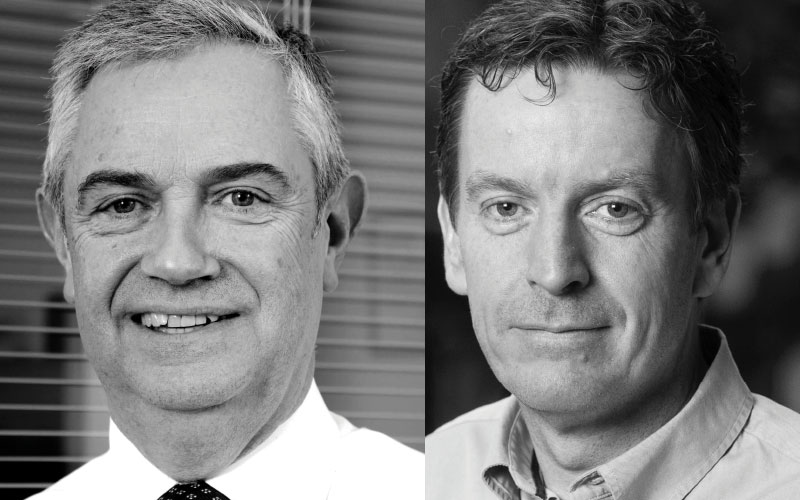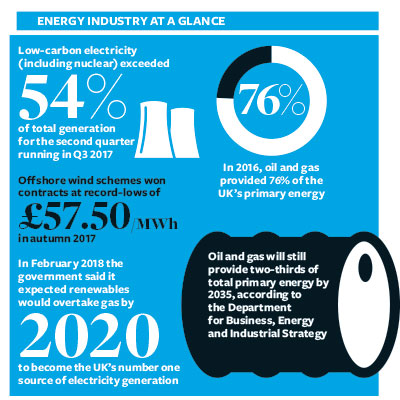View from the top: Ian Funnell and Carl Ennis
To celebrate our 75th year, Energy Focus talks with Ian Funnell, Managing Director at ABB, and Carl Ennis, Managing Director at Siemens – two of our founding member companies – about some of the issues facing the energy industry

Ian Funnell, UK Managing Director at ABB
(Picture - above left)
How do you see the energy sector developing in the UK over coming years?
I don’t think the energy market in the UK, or indeed globally, has ever been such an exciting place to work. We stand on the point of a true revolution in energy, with a wide variety of concurrent changes happening.
These include the rapid growth and connection of distributed renewable generation and storage; demand side response technologies and services; ultra HVDC transmission for greater efficiency over long distances; hydrogen for transport and heating; and the electrification of transport. And in upstream oil and gas, there’s subsea production, and digitalisation right along the energy chain. Even carbon capture and storage is back on the agenda.
I am also convinced that some of these changes will support and enable commercial innovation in the energy sector that will be truly disruptive. ABB is involved in all aspects of the energy train, from power generation to plug, so I am looking forward to ABB playing a big role over the next few years in helping drive the energy transformation.

What does the UK’s future energy mix look like?
There has been a rapid rise in renewable electricity generation over recent years, mostly from wind, but also with contributions from solar and even tidal – I’m proud to have been involved in the MeyGen tidal project in Scotland.
The rise in renewable electricity has been matched by a continued fall in fossil fuel generation – helping drive UK CO2 emissions down to 1890 levels. The shift of generation within the electrical system will continue, with battery storage and increasingly sophisticated network management systems making this commercially feasible.
But the biggest challenge will come from decarbonising transport and heating, which are still very much dominated by fossil fuels. Although the UK lags behind many other parts of the world in the electrification of rail and road transport, the numbers of electric vehicles (EVs) and buses are set to rise sharply, which would cause another significant shift in the energy mix and decline in CO2 emissions – providing the power comes from low-carbon sources.
The speed of adoption of EVs is highly dependent on the roll-out of power and data infrastructure, and while the market may deliver this, it is my view that the government needs to be more active. Similarly, limited government support has led the pace of rail electrification to slow. We will work with the industry to try and get the electrification process back on track.
One other key change in the energy mix will be the degree to which systems are localised – power demand and supply will increasingly be balanced locally.
How will oil and gas fit in with a low-carbon economy?
Oil and gas will continue to play a major role in transport, heating and flexible generation for many decades to come. The internal challenge for the sector remains to maximise the production efficiency of existing assets and to open up new commercial opportunities through further cost reduction. Subsea processing, in particular, offers a potentially significant cost reduction, and carbon capture and storage can be used to reduce the impact of carbon emissions. At the same time, energy efficiency measures for buildings and transport will cut demand and environmental costs.
What is the case for hydrogen energy?
Hydrogen potentially offers an attractive alternative for heating, electricity generation and transport applications. Major challenges remain in producing the hydrogen without CO2 or in capturing the CO2, and adapting the existing pipeline distribution network to take hydrogen. However, if these challenges can be overcome, hydrogen will be a useful new element in the overall energy mix.
About ABB
ABB is a pioneering technology leader that works closely with utility, industry, transport and infrastructure customers worldwide. With a heritage spanning more than 130 years, ABB operates in more than 100 countries and employs around 135,000 people.
About Ian Funnell
Ian Funnell joined ABB originally in 1999. After a spell in UK utilities, Ian rejoined ABB in November 2012 as Group Vice President of the global utility sector, and then as CEO and President of ABB SA (France). He was appointed Managing Director of ABB UK in January 2015. Ian Funnell is a graduate of Aberdeen University in Engineering Science. He is a Fellow of the Institution of Engineering and Technology, a Fellow of the Institute of Directors and a member of the World Economic Forum Taskforce for Infrastructure Investment.
Carl Ennis, Managing Director for Siemens Energy Management, UK and Ireland
(Picture - above right)
What does the UK’s future energy mix look like?
Firstly, we’re very supportive of the work the system operator, National Grid, does annually to assess the Future Energy Scenarios, but looking at how much the report has changed over the past few years tells us no-one really knows what the future will look like!
At Siemens, we have an advantage – as a founding member of the EIC some 75 years ago, we’ve experienced quite a lot of change ourselves. But what remains important is to continually question what you’re doing today and look at what might be required tomorrow.
One of the biggest challenges in the energy sector is policy stability… policymakers are normally more short-term, and we spend a lot of time helping them look a little further out
I’d suggest that as part of the decarbonised power sector, we will have a large-scale chemical energy storage capability (hydrogen or ammonia) and a small number of large-scale, fast-acting power generating facilities.
Renewable generation will continue to grow, with smaller-scale embedded generating facilities becoming an increasingly large contributor to this growth, alongside small or medium storage facilities to support and stabilise systems. There will also need to be a significant change in how the system is managed – from a uni-directional hierarchical system, to a true network, allowing intelligent load control, two-way power flows, and demand flexibility.
This will be driven by the industry’s increasing focus on the energy consumer who, I believe, will ultimately demand changes to ensure sustainability.
What is the case for new gas storage?
Historically the case has been strong for new gas storage, but the absence of new large combined cycle power station winners in recent capacity auctions, tends to suggest that gas demand for power generation is unlikely to grow further.
However, there is an energy crunch coming in the mid-2020s as coal is phased out and all but one of the old nuclear plants closes. This means the power market needs active management to ensure demand is met, and we still see a role for large combined cycle gas turbines in this. In addition, gas for heating remains highly seasonal, and this demand is unlikely to fall for some time to come.
What is the case for 3D printing in civil nuclear energy? How will digitalisation affect the future of the energy industries?
There are interesting developments in the civil nuclear sector for small modular reactors, which are smaller, standardised units, shipped and installed where needed to support the local system. It remains to be seen whether the government will go ahead with a programme and whether the regulator’s technology approval process would allow 3D printing.
At Siemens we are already using 3D technology and have recently announced a £27m investment in our materials solutions facility in Worcester. While many organisations use 3D printing to validate parts before they are produced, we have produced actual gas turbine blades, which opens up a whole new way of manufacturing.
What are the biggest challenges being faced by energy?
One of the biggest challenges in the energy sector is policy stability. In most instances, solutions require heavy capital investment, and need clarity of policy over 10 or 20 years. Policymakers are normally more short-term, and we spend a lot of time helping them look a little further out.
Another common challenge is customers’ desire to extract enhanced value from their investments. Now this is not a new challenge, but we do have a new tool... digitalisation. Data alone is not the answer, but combined with our extensive experience, customer knowledge and our new cloud-based Internet of Things platform, MindSphere, we’re able to unlock significant additional value.
About Siemens With more than 170 years of innovation, Siemens is a global powerhouse positioned along the electrification value chain as well as in the areas of medical imaging and laboratory diagnostics. Today, Siemens has around 377,000 employees in more than 200 countries/regions.
About Siemens
With more than 170 years of innovation, Siemens is a global powerhouse positioned along the electrification value chain as well as in the areas of medical imaging and laboratory diagnostics. Today, Siemens has around 377,000 employees in more than 200 countries/regions.
About Carl Ennis
Carl joined Siemens in 1997. After leaving to become Managing Director of Weir Valves and Controls, he returned to Siemens in 2004 to manage Siemens Transmission and Distribution’s service business. Having held other senior management roles, Carl moved to Shanghai, China, where he was responsible for Power Generation Services in Asia Pacific, returning to the UK in January 2015 to take up his latest role. Carl graduated from Manchester Metropolitan University with an honours degree in Integrated Engineering Systems.






Follow us
Advertise
Free e-Newsletter